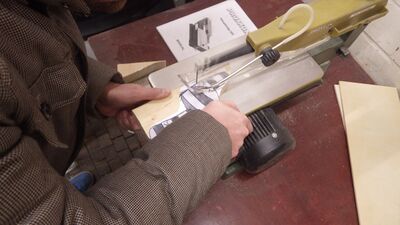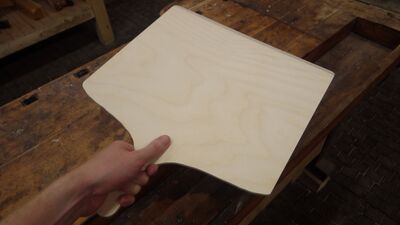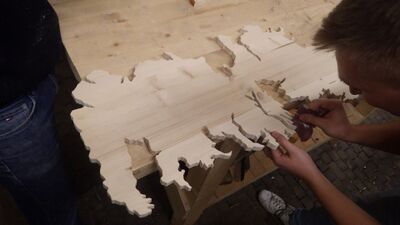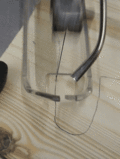Scroll Saw
| MachineInfoBox Proxxon DSH | |
|---|---|
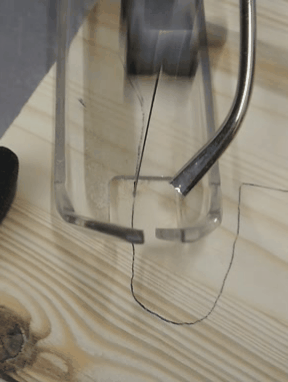
| |
| Synonyms: | "fretsaw machine"; DE: Dekupiersäge, Feinschnittsäge |
| Material: | wood, plastics, non-ferrous metals |
| Access Requirements: | Scroll Saw Introduction |
| Manual: | amazon.com PDF |
| Tutors: | Lukas NitramLegov Pakue Johannes Luzian |
| Similar (More or Less): | fretsaw, bandsaw, laser cutter |
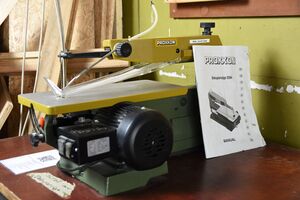
A scroll saw can be described as a powered fretsaw: two arms at the top and bottom hold a thin saw blade and vibrate quickly. The workpiece is pushed through the otherwise stationary saw blade to cut. It is a very versatile tool and can be used to cut wood, plastics or many metals to obtain intricate shapes. For larger pieces with wider curves you may want to use a jigsaw.
Cutting capacity is 50 mm in wood, 30 mm in plastics and 10 mm in non-ferrous metals. [1]
Don't forget to wear personal protection and hook up a shop vac when you use it!
Saw Blades
Saw blades have to be changed frequently due to wear, different materials or simply because you want to cut a hole and have to enter the workpiece.
We use quick-release saw blades with pins on both ends, do not screw these in or they will break! Saw blades without pins have to be secured by screws on both arms of the machine. The teeth of the saw blade always have to point down and a hole will need to be at least 5.3 mm in one direction for the blade to fit through because of these pins.
Changing Saw Blades
- unplug the machine
- turn the tensioner (knob in the back) counterclockwise to loosen
- push the top arm down
- unhinge the saw blade from the top and bottom arm
- insert a new saw blade (teeth pointing down, pins carefully hooked in their grooves)
- turn the tensioner clockwise until the blade makes a high-pitch noise when plucked
- continue working
Types of Saw Blades
| MaterialInfoBox Scroll Saw Blades | |
|---|---|
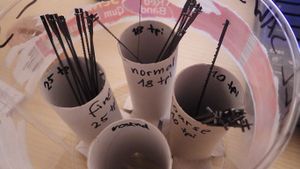
| |
| Synonyms: | DE: Dekupiersägeblätter |
| On Site? | soon |
| Location: | wall above scroll saw |
| Suggested Tools: | scroll saw |
Your material and to some extent also the design you want to cut dictate which saw blades can be used.
Our scroll saw works with 127 mm saw blades which come in different versions:
- coarse (10 teeth per inch/25 mm)
- appropriate for soft and hard wood and thick materials
- Proxxon NO 28 741
- normal (18 teeth per inch/25 mm)
- fine (25 teeth per inch/25 mm)
- appropriate for plastic, glass-fibre reinforced plastic, non-ferrous metals, acrylic glass and wood
- Caution with acrylic glass: the material tends to weld the cut closed due to the high temperature being generated and thus prevents backward motion - make sure you will be able to cut in one go or you might get stuck! Consider drilling relieve holes along the cutting path to allow for easy turning and exit points. Also cutting straight lines into acrylic glass tends to result in wave-like patterns as the blade is flexible and therefore oscillates around the cutting path.
- Proxxon NO 28 745
- appropriate for plastic, glass-fibre reinforced plastic, non-ferrous metals, acrylic glass and wood
round (16 teeth per cm)
Where to Cut?
Even for a "free-hand" design you make your work easier if you sketch the cut on your workpiece, e.g. with a pencil on wood or a scriber on metal and plasic. For printed plans, the easiest option is to glue them onto the workpiece - with glue sticks (they're water soluble) or onto a layer of masking tape which should later peel off without a trace.
Inspiration
Here are some examples of projects you could use the scroll saw for:
-
children's toys like a Tigerente
-
simple pizza peels
-
the "Game of Thrones" continent of Westeros
- it's possible to cut spirals/helices with the scroll saw (by hand or with a motorized jig)
- (mostly German) collection of project ideas & cutting plans
